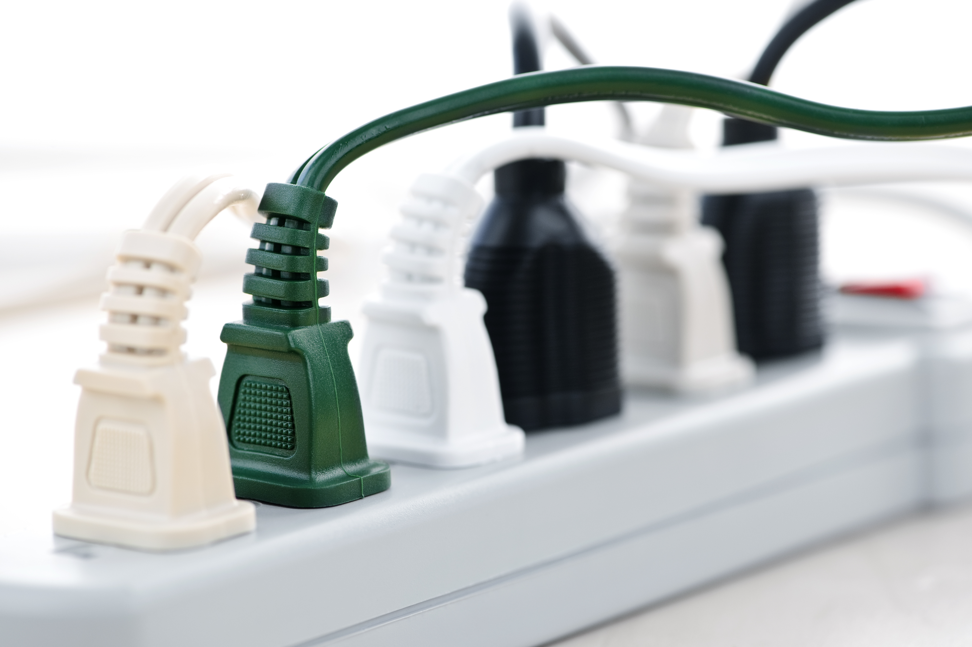How to Safely Use a Power Strip

Power strips are commonly used in homes. They allow you to plug in multiple devices when just one socket is available. But if a power strip is misused, an overload, fire, or other electrical emergency can occur. To avoid problems, we’ll explain how the device works and how to use it correctly to prevent damage or injuries.
What Is a Power Strip?
A power strip is a device with multiple electrical sockets and a flexible cable at the end. The cable has a plug that fits into a wall receptacle like a standard device plug. Power strips are often confused with surge protectors, but the two are completely different. A standard strip simply provides more sockets to plug things into. Some surge protectors look like power strips but also protect devices and wiring from spikes in voltage.
If a power strip has a built-in surge protector, the label on the box will say so. The unit will also have a light or switch indicator. You can also purchase a separate surge protector to protect electronics and appliances. It can split an outlet the way a basic power strip does. But using a standard power strip as a surge protector won’t safeguard any appliance, device, or circuit (a whole-house surge protector offers the highest level of protection).
When to Use a Power Strip
A power strip is a convenient item to have. But it does have limitations. It is best suited for plugging in a low-power device that’s used near, for example, a computer or television. However, you do not want to use one:
- Long Term: Power strips aren’t designed to be plugged in for more than a few days or a week or two. Have more sockets installed by an electrician if you require more capacity for the long term.
- For Major Appliances: Do not plug a refrigerator, microwave, air conditioner, space heater, or power tools into a power strip. They can be damaged, or you could trigger an electrical fire.
- Near a Heat Source: A power strip can catch fire if it’s exposed to high heat. Do not install one where fabric or cloth may cover it. Being covered or confined can cause the strip to overheat.
Can I Plug a Power Strip Into Another Power Strip?
Never plug one strip into another or an extension cord. This is a fire hazard. Only plug a power strip into a single outlet. You’ll avoid a fire or having to repair serious damage or replace costly electronics. Also, check the power strip’s voltage and wattage rating. Make sure the unit is rated for the power going through it; exceeding its capacity can put your safety at risk.
Can You Use a Power Strip Outside?
Not every power strip is made the same. Most units are designed for indoor use only. If you intend to use one outside, check the packaging to see if it is an outdoor-rated power strip. And always check the unit’s voltage rating. To be safe, calculate your voltage requirements before selecting a power strip and connecting devices to it.
Know When You Need a More Permanent Solution
Power strips do not increase electrical capacity. If you need to use a strip often, consider installing more electrical outlets, including the latest three-prong units and ground fault circuit interrupters; a GFCI/GFI outlet adds a layer of protection by tripping if an overload, current imbalance, or moisture is detected. Therefore, you’re protected from a shock or burn. You can also purchase a weatherproof, waterproof GFI power strip for additional protection, especially in outdoor applications.
Contact Express Electrical Services
A power strip is just a temporary solution. If you need more electrical capacity, our trained electricians can provide the necessary updates, including adding outlets, rewiring your home, or upgrading your electrical panel. They’re experienced and equipped with the latest tools to assess your electrical needs and get the job done safely and efficiently. Call (888) 741-6404 or contact us online for same-day electrical service.

Leave A Comment